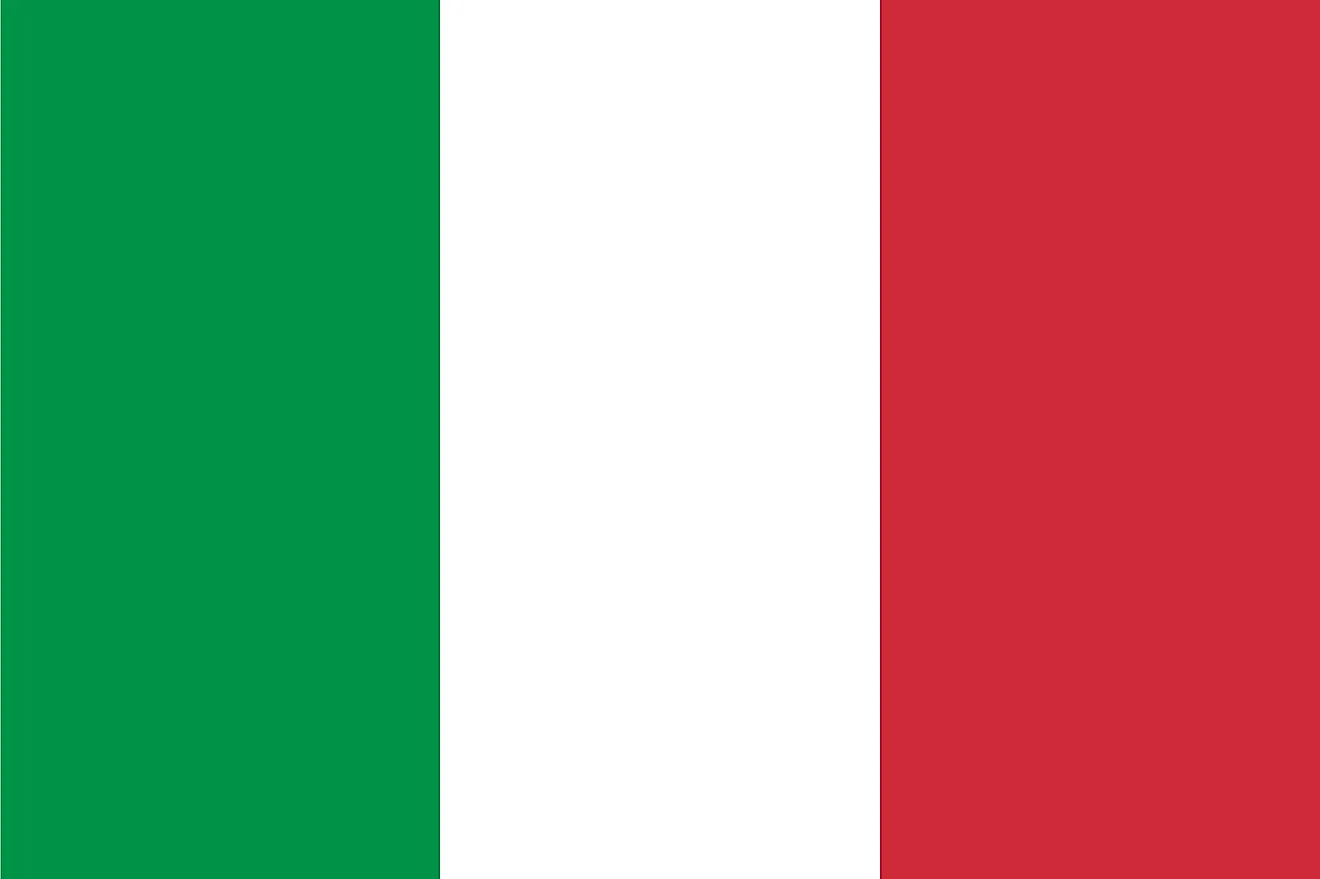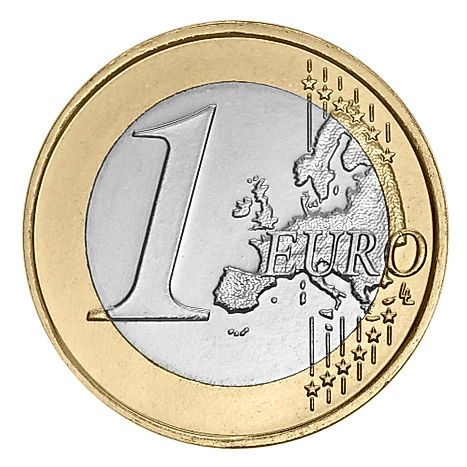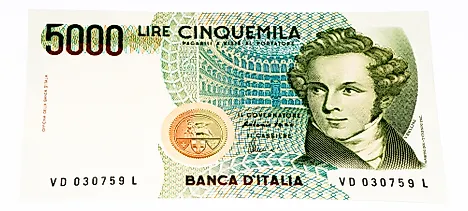Flags, Symbols, & Currencies of Italy

The national flag of Italy is one of the country’s most recognized national symbols. The flag has one of the best-known designs of any national flag in the world, which is comprised of a vertical tri-band of three colors, a design that earns the flag its nickname, the "tricolore." Italy introduced the “tricolore” as its national flag on June 1946, but it was on January 1st, 1948 that the flag was officially adopted. The use and displaying of the flag is stipulated in the Constitution of Italy. The design of the flag mirrors that of the national flag of France with the only difference being the presence of a blue stripe on the flag of France in place of the green stripe seen on the flag of Italy.
Description and Symbolism
The flag of Italy has a horizontal rectangular design whose width and length proportions are 2:3. As its name alludes, the “Tricolore” is made up of three differently-colored stripes which are green, white, and red. The stripes run vertically down the flag and each of the three stripes has equal width. The law is not clear on the symbolism of the colors of the flag of Italy, so all possible attributed meanings are speculation. One explanation is based on religion where the symbolism of the colors is tied to positive virtues. In this religious explanation, the green color is said to represent hope, red symbolizing charity, and white stands for faith. Another theory is based on the country’s geography and history. This interpretation has it that red symbolizes the bloodshed during Italy’s war of unification and independence, while the white stands for the snow-capped peaks of the Alps, and green represents the greenery that covers the country’s plains.
History
The history of the “Tricolore” goes back to the 18th Century in late 1794 when a group of students in the then papal state of Bologna rallied against the oppressive Catholic government. The style of the distinctive three colors was incorporated in the design of the flag of the Cispadane Republic in 1797. The “tricolore” would later be adopted as the flag of the Kingdom of Italy in 1851, and this version closely resembled the current national flag of Italy. The only differentiating feature was the coat of arms of Savoy located at the center of the flag. Before the adoption of the current flag of Italy, the country used the RSI flag as its national flag. Also known as the flag of the Republic of Salo, the flag was identical to the country’s national flag. However, the civil ensign had the image of an eagle charged on the middle white stripe.
Other Flags
The flag of Italy has several variants apart from the official national flag. One variant is the country’s civil ensign which is charged with a shield. The civil ensign was adopted in November 1948. Another official flag in Italy is the state ensign which is defaced with a golden coat of arms. The state ensign is the most recent of Italy’s official flags as it was introduced in 2000.
Symbols of Italy
National Coat of Arms of Italy

Italy's coat of arms has been the symbol of the Italian Republic since 5 May 1948. The emblem comprises a white five-pointed star, with a red border, superimposed on a five-spoked cogwheel which stands between an olive branch on its left and a branch of oak on its right. The branches in turn are bound by a red ribbon bearing the legend "REPVBBLICA ITALIANA" (Italian Republic)
National Anthem
- Anthem Title: Il Canto degli Italiani
- Music composer: Michele Novaro
- Lyricist: Goffredo Mameli,
- Date of Adoption: 1946
The national anthem of Italy, "Il Canto degli Italiani," was written by Goffredo Mameli in 1847, with Michele Novaro composing the music in the same year. The anthem is popularly known as "Inno di Mameli" (Hymn) in Italy, in honer of the song writer. Although the anthem was a popular song during the unification of Italy, it was not the official anthem. Instead, the "Marcia Reale" was the official anthem of the Kingdom of Italy. Inno di Mameli was chosen as Italy's provisional national anthem when the country became a republic on October 12, 1946. However, it was not until December 4, 2017 that the song became the official national anthem of Italy.
Il Canto degli Italiani (Italian)
Fratelli d'Italia,
l'Italia s'è desta,
dell'elmo di Scipio
s'è cinta la testa.
Dov'è la Vittoria?
Le porga la chioma,
ché schiava di Roma
Iddio la creò.
Coro
Stringiamci a coorte,
siam pronti alla morte.
Siam pronti alla morte,
l'Italia chiamò.
Stringiamci a coorte,
siam pronti alla morte.
Siam pronti alla morte,
l'Italia chiamò! Sì!
Noi fummo da secoli
calpesti, derisi,
perché non siam popolo,
perché siam divisi.
Raccolgaci un'unica
bandiera, una speme:
di fonderci insieme
già l'ora suonò.
Coro...
Uniamoci, amiamoci,
l'unione e l'amore
rivelano ai popoli
le vie del Signore.
Giuriamo far libero
il suolo natio:
uniti, per Dio,
chi vincer ci può?
Coro......
Dall'Alpi a Sicilia
dovunque è Legnano,
ogn'uom di Ferruccio
ha il core, ha la mano,
i bimbi d'Italia
si chiaman Balilla,
il suon d'ogni squilla
i Vespri suonò.
Coro.....
Son giunchi che piegano
le spade vendute:
già l'Aquila d'Austria
le penne ha perdute.
Il sangue d'Italia,
il sangue Polacco,
bevé, col cosacco,
ma il cor le bruciò.
Coro....
The Song of the Italians
Brothers of Italy,
Italy has woken,
bound Scipio's helmet
Upon her head.
Where is Victory?
Let her bow down,
Because [as a] slave of Rome
God created her.
Let us join in a cohort,
we are ready to die.
We are ready to die,
Italy has called.
Let us join in a cohort,
We are ready to die.
We are ready to die,
Italy has called! Yes!
We were for centuries
downtrodden, derided,
because we are not one people,
because we are divided.
Let one flag, one hope
gather us all.
The hour has struck
for us to unite.
Chorus
Let us unite, let us love one another,
Union and love
Reveal to the peoples
The ways of the Lord.
Let us swear to set free
The land of our birth:
United, by God,
Who can overcome us?
Chorus
From the Alps to Sicily,
Legnano is everywhere;
Every man has the heart
and hand of Ferruccio
The children of Italy
Are all called Balilla;
Every trumpet blast
sounds the Vespers.
Chorus
The mercenary swords
Are feeble reeds.
Already the Eagle of Austria
Has lost its plumes.
The blood of Italy,
the Polish blood
It drank, along with the Cossack,
But it burned its heart.
Chorus
The Currency of Italy is the Euro
The currency of Italy is Euro, adopted on January 1, 2002. The Italian Euro is abbreviated as € and its international code is EUR. It exists in denominations of €5, €10, €20, €50, €100, €200 and €500. The Italian currency notes are printed by the Bank of Italy which also acts as the regulator. On the other hand, the coins are minted by State Printing Works in support of the Ministry of Finance and Economy. Other places where the Euro is used include Slovenia, Greece, Austria, Estonia, Luxembourg, Finland, Belgium, Spain, Cyprus, Portugal, Slovakia, Malta, Lithuania, Germany, France, Ireland, Latvia, and Netherlands.
The Italian Banknotes
Italian euro notes were introduced in 1999 in denominations of 5, 10, 20, 50, 100, 200 and 500 euros. The Bank of Italy started issuing the banknotes in 2002 according to the rules and regulations that control the Euro system. As a member of the Eurozone, the Bank of Italy produces the number of notes given to it, circulates them, removes the worn-out notes, and participates in the search for new security features. It then contributes towards the definition of regular standards for purposes of ensuring the quality of notes circulated and to fight against counterfeiting. Furthermore, the Bank of Italy also employs power of control over those who handle cash. In instances where the rules are violated, it may decide to embrace restrictive measures and levy pecuniary administrative sanctions.
Historical Currencies of Italy
Italy used the “lira” as its currency before adopting the euro in 1999. The lira was replaced by euro at a rate of 1, 936.27 lira being equivalent to 1 euro. It took the Bank of Italy two years to exchange all lira notes and coins to the Euro. The Euro currency was developed with the main objective of creating a monetary and economic union for all the European Union states apart from Denmark and the United Kingdom. The minting of the new notes and coins kicked-off in 1998 and lasted for a period of four years. In 2002 the physical banknotes and coins started circulating in the economy.
The Italian coins were introduced in the year 1861. They were in the denominations of 1, 2, 5, 10, 20, 50, 100, 200, 500 and 1000 liras. The coins were struck in silver, nickel, stainless steel, aluminum, gold, aluminum-bronze, copper-nickel and bi-metallic. However, the Italian lira was no longer circulated in the country’s economy after the adoption of the euro currency. The Italian euro coins are uniquely designed. They have the twelve stars of the European Union, the protruding letters which stand for the Italian Republic, the year of design and letter R which stands for Rome.















